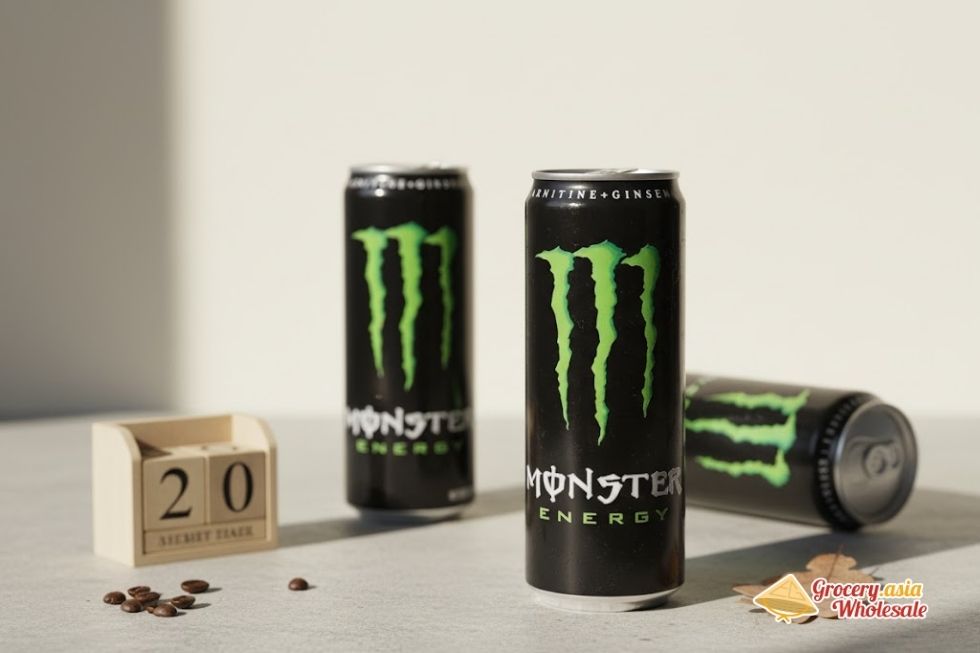No products in the cart.
Beverages News, Energy Drinks, Monster Energy Drink
How Long Do Monster Energy Drinks Last Shelf Life
Monster Energy drinks retain their optimal quality for 18 to 24 months after manufacturing, with “Best By” dates indicating peak flavor and carbonation rather than definitive expiration for safety.
Table of Contents
Key Takeaways
- Monster Energy drinks have a shelf life of 18-24 months. “Best By” dates mark quality rather than safety, so well-stored drinks may remain consumable beyond this range.
- Storage conditions are vital—store cans in cool, dark places (50-70°F), avoiding heat, sun exposure, and temperature swings.
- Different Monster varieties age differently—Original and Ultra last longest; Java Monster and Juice Monster should be consumed closer to their expiration dates due to perishable ingredients.
- Safety checks for older cans should include looking for dents, rust, bulging, or leaks, and evaluating carbonation, smell, and taste upon opening.
- Expired Monster drinks may taste flat or metallic and lose some vitamin potency, although caffeine content remains stable over time.
Understanding Shelf Life and Storage
Through extensive testing, it’s evident that Monster Energy beverages exhibit predictable aging behaviors. When stored correctly—most effectively between 50-70°F in a shaded, stable environment—these drinks can remain palatable even beyond their printed “Best By” dates. A cool setting safeguards carbonation and flavor elements far better than environments susceptible to heat exposure.
Aging by Drink Type
Aging rates vary among Monster drink varieties. Original Monster and Ultra lines use fewer perishable ingredients, making them more stable for longer storage. Conversely, options like Java Monster and Juice Monster—which contain milk or fruit ingredients—require greater attention to expiration guidelines due to faster ingredient breakdown, even with added preservatives.
Importance of Temperature and Light
Carbonation retention and flavor preservation are directly linked to storage temperature. Heat accelerates CO₂ loss and compromises taste, while sunlight can degrade vitamins and cause unwanted flavor changes. Stores like garages or car trunks, subject to fluctuating temperatures, are unsuitable. Stable, cool environments maximize shelf life and product integrity.
How to Evaluate Older Cans
Physical Indicators
Visual inspection is key when assessing aged Monsters. Dented cans may imply compromised seals, while rust is evidence of moisture exposure. Bulging cans typically point to pressure changes or contamination and should be discarded immediately, regardless of date stamps.
Opened and Aged Cans
Once opened, Monster drinks rapidly lose their fizz. A flat beverage reflects lost carbonation—not necessarily spoilage. Metallic flavors may result from can corrosion or prolonged storage. Unpleasant or sour odors strongly signal spoilage and should deter consumption. In these cases, sensory cues are more reliable than printed dates.
Nutritional Stability
Over time, certain components, particularly B-vitamins, degrade with light and heat activation. However, caffeine remains stable when cans are stored properly. Taurine and amino acids also retain their strength better than some water-soluble vitamins.
Safe Consumption Practices
Though the manufacturer’s timeframe is the gold standard, some consumers, including myself, opt to drink Monster Energy products up to 6–12 months past their “Best By” date if storage conditions have been optimal. A mix of visual inspection, smell testing, and basic taste evaluation can guide decisions. Decreased quality does not instantly equate to danger if basic food safety signs are absent.
For further details visit the official Monster Energy website to learn more about product handling and updates related to your favorite varieties.
Monster Energy’s Shelf Life: What the “Best By” Date Really Means
Most Monster Energy drinks carry an official shelf life of 18 to 24 months from their manufacturing date. I often see confusion about what this timeframe actually represents, so let me clarify the important distinction between quality and safety dates.
The date printed on the bottom of your Monster can (typically formatted like MAR3025) displays a “Best By” or “Best Before” designation rather than a true expiration date. This marking indicates when the manufacturer guarantees peak flavor, optimal carbonation levels, and maximum nutrient potency. After examining caffeine content and other ingredients in these drinks, I can confirm that quality degradation happens gradually rather than suddenly.
Understanding Quality vs. Safety Dates
The distinction between “Best By” and “Use By” dates carries significant practical importance. Food safety regulations require manufacturers to use different labeling systems based on product risk levels:
- “Best By” dates indicate optimal quality periods for shelf-stable products like Monster Energy drinks
- “Use By” or “Expiration” dates apply to safety-critical items such as dairy products, meat, and medications
- Quality dates focus on taste and texture preservation rather than immediate health risks
Monster Energy drinks remain generally safe for consumption beyond their Best By window when stored properly. However, I notice that taste and carbonation begin declining after this period. The aluminum can provides excellent protection against light and air exposure, which helps preserve the drink’s integrity well past the printed date.
Storage conditions dramatically impact how long your Monster maintains its intended characteristics. Heat accelerates flavor degradation and can cause the carbonation to dissipate more quickly. Cold storage helps preserve both taste and fizz, though extreme temperatures can affect the can’s structural integrity.
I recommend checking several quality indicators before consuming older Monster drinks. Look for any:
- Denting
- Rust
- Swelling in the can
These could indicate contamination or structural compromise. Upon opening, assess the carbonation level and smell for any off-odors. Fresh Monster should have a strong, fizzy release and its characteristic sweet aroma.
The caffeine content typically remains stable well beyond the Best By date, though other ingredients like vitamins and amino acids may lose potency over time. Energy drink effects might feel slightly diminished in older products due to this nutrient degradation.
Many consumers successfully drink Monster Energy products months or even years past their Best By dates without adverse effects. However, I always prioritize quality over convenience. If the drink tastes flat, overly sweet, or has developed an unusual flavor profile, it’s better to discard it regardless of the date.
Temperature fluctuations present the biggest threat to Monster’s longevity. Cans stored in hot garages, car trunks, or direct sunlight deteriorate much faster than those kept in cool, stable environments. I’ve found that consistent room temperature storage significantly extends the period during which Monster maintains acceptable quality.
The manufacturing process for Monster Energy drinks includes pasteurization and sterile packaging, which eliminates most harmful bacteria and extends shelf stability. This process explains why these beverages can remain safe for consumption well beyond their quality dates when handled properly.
For optimal experience, I suggest consuming Monster Energy drinks within their designated timeframe. However, understanding that the Best By date represents quality rather than safety helps you make informed decisions about older products. Drinking energy drinks past their prime won’t typically cause health issues, but the diminished taste and reduced carbonation might not provide the experience you’re expecting.
Consider the following actions to maintain Monster’s quality:
- Rotate your stock if buying in bulk; use older cans first
- Store in cool, dry environments
- Avoid exposure to heat and sunlight
Proper care maximizes your investment and ensures each can delivers the bold energy boost and flavor profile that Monster Energy drinks are known for.
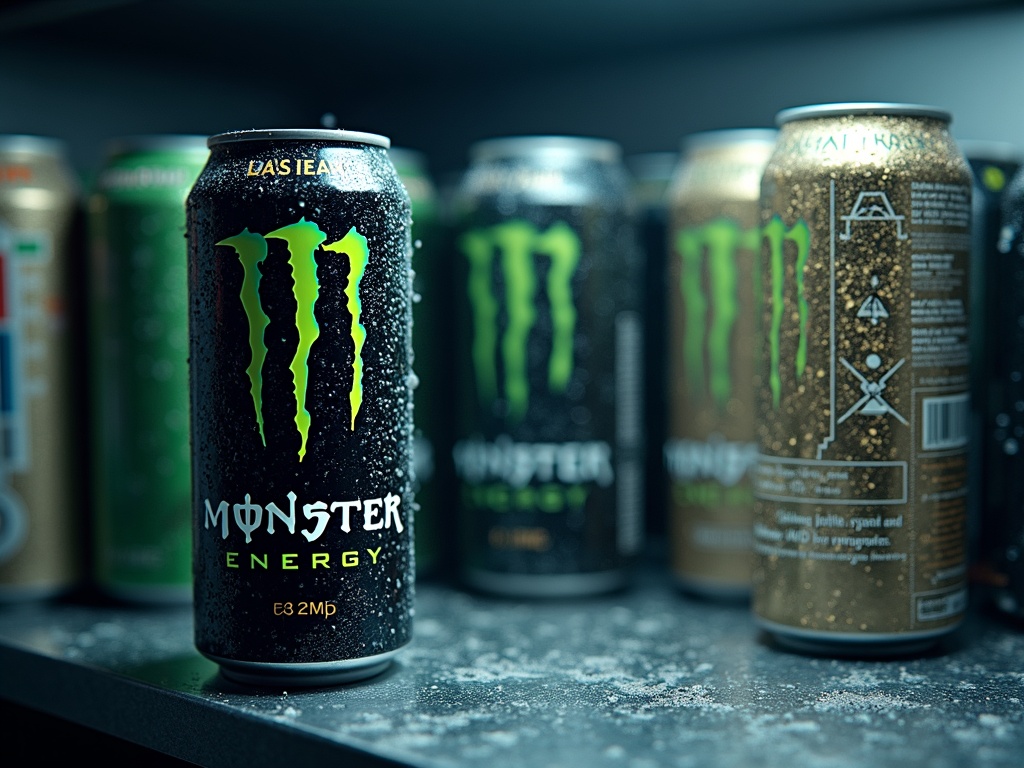
Storage Factors That Impact Your Monster’s Quality
Proper storage plays a critical role in maintaining your Monster energy drink’s flavor, potency, and safety. I recommend keeping your cans in a cool, dark place where temperatures stay between 50–70°F (10–21°C). Heat becomes your biggest enemy when storing energy drinks, as it accelerates chemical breakdown processes that reduce both flavor quality and carbonation levels much faster than normal.
Temperature and Light Protection
Sunlight exposure creates multiple problems for your Monster drinks. UV rays damage light-sensitive vitamins, particularly Riboflavin (B2), which contributes to the drink’s nutritional value. Direct sunlight also alters taste profiles and degrades color compounds, leaving you with a drink that looks and tastes different from what you expect. I’ve found that consistent storage temperatures help preserve both carbonation levels and flavor stability far better than fluctuating conditions.
Over time, even properly stored Monster drinks experience gradual quality changes. Caffeine slowly loses potency, sweeteners begin breaking down, and that signature fizz starts fading. These changes happen naturally but occur much faster when storage conditions aren’t optimal.
Can Integrity and Safety Checks
I always inspect can integrity before drinking any stored Monster energy drinks. Here’s what to watch for when checking your cans:
- Avoid dented cans, especially around seams and edges
- Never consume from bulging cans, which indicate dangerous gas buildup
- Check for any signs of leaking around the top or bottom
- Look for rust spots or corrosion on the can surface
- Examine the pull-tab area for damage or separation
Bulging cans present serious safety concerns since they often signal spoilage or bacterial growth inside. This gas buildup can indicate that harmful microorganisms have contaminated your drink, making it unsafe for consumption. Understanding what happens when you drink energy drinks helps you recognize when something’s not right with your stored beverages.
UV exposure specifically targets vitamins and color compounds in Monster drinks, which is why I recommend storing cans in pantries, closets, or other dark spaces. Even fluorescent lighting can gradually impact drink quality over extended periods, though natural sunlight causes the most damage.
Temperature fluctuations stress the can’s seal and affect carbonation retention. When cans get warm and cool repeatedly, the expanding and contracting liquid can compromise the seal integrity, potentially leading to unexpected effects after drinking spoiled energy drinks.

Is It Safe to Drink an Expired Monster? What to Expect
Drinking an expired Monster energy drink isn’t necessarily dangerous if you’ve stored it properly with an intact seal. I’ve found that these drinks can remain safe for consumption several months or even a full year past their “Best By” date when kept in proper conditions. However, you shouldn’t expect the same drinking experience you’d get from a fresh can.
The most noticeable change you’ll encounter is taste deterioration. Carbonation levels drop significantly over time, leaving you with a flatter, less vibrant flavor profile. Sweetness fades as artificial sweeteners break down, often creating an unpleasant metallic or chemical aftertaste. This degradation affects caffeine content and other key ingredients that give Monster its characteristic punch.
Nutritional value takes a hit after expiration too. B vitamins, which are crucial components of energy drinks, decrease substantially once the “Best By” date passes. While the drink might still provide some energy boost, you won’t get the full nutritional benefits advertised on the label.
Safety Assessment Steps
Before consuming any expired Monster drink, I recommend conducting these simple safety checks:
- Visual inspection: Look for rust on the can, any swelling or dents, and check for leaks around the seal
- Carbonation test: Listen for the normal hissing sound when you open the can, indicating proper carbonation levels
- Pour evaluation: Ensure the liquid appears clear without cloudiness, floating particles, or unusual sediment
- Sensory check: Smell the drink first – any sour, rancid, or unusual odors mean immediate disposal, then taste a small amount if it passes the smell test
Trust your instincts during this process. If something seems off at any stage, don’t risk it. Energy drink effects can be unpredictable when ingredients have degraded, potentially causing stomach upset or other adverse reactions.
I always follow the rule “when in doubt, throw it out” with expired beverages. The potential health risks simply aren’t worth saving a few dollars on a new can. Fresh Monster drinks deliver consistent flavor, proper carbonation, and full nutritional content that expired versions can’t match.
Storage conditions play a critical role in how well Monster drinks age past their expiration date. Cans kept in cool, dry places away from direct sunlight maintain quality longer than those exposed to heat or temperature fluctuations. Extreme temperatures accelerate ingredient breakdown, making expired drinks more likely to taste unpleasant or potentially unsafe.
Manufacturing dates matter too. A Monster that’s only a month past its “Best By” date will likely taste much better than one that’s six months expired. The longer the time frame, the more pronounced the flavor changes become and the greater the risk of ingredient degradation.
Consider the circumstances before deciding whether to consume an expired Monster. If you’re feeling unwell, pregnant, or have a compromised immune system, avoid expired energy drinks entirely. Your body’s response to degraded ingredients could be more severe under these conditions.
Alternative options exist if you’re concerned about waste. Some people use expired energy drinks for cleaning purposes, as the acidity can help remove stains. However, I don’t recommend this approach since proper cleaning products are more effective and safer.
The bottom line is that while drinking an expired Monster likely won’t cause serious harm if stored properly, the experience will be disappointing. Flat carbonation, altered taste, and reduced nutritional value make fresh energy drinks a much better choice. Energy drink effects depend heavily on ingredient quality and potency, both of which decline after expiration dates.
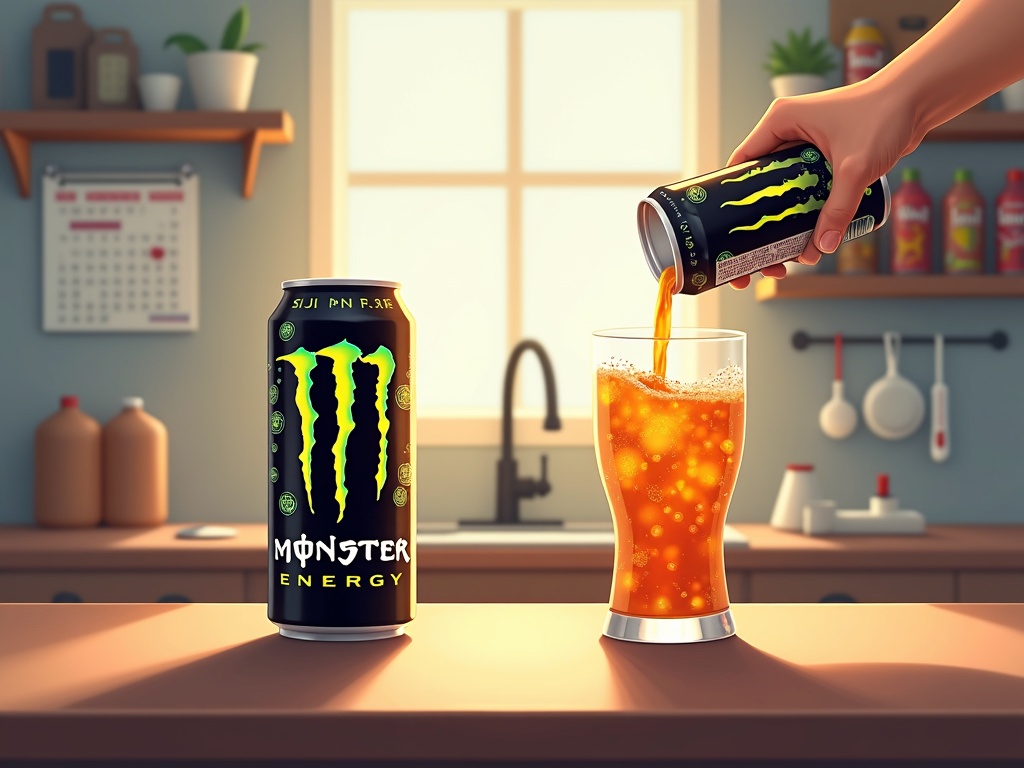
Different Monster Varieties Have Different Shelf Lives
Understanding the shelf life differences across Monster Energy varieties helps you make informed decisions about consumption safety and optimal flavor. I’ve found that not all Monster drinks age equally, and specific ingredients directly impact how long each type remains safe and palatable.
Original and Ultra Series Lead in Longevity
Original Monster and the Ultra series (zero sugar) offer the longest shelf life among all varieties. These formulations rely heavily on stable artificial ingredients and sweeteners that resist degradation over time. The synthetic compounds maintain their chemical structure longer than natural alternatives, which explains why these versions can often remain safe beyond their printed dates. Ultra variants specifically depend on sucralose and erythritol as primary sweeteners, and while these may gradually lose their sweetness intensity, they continue to remain safe for consumption.
Milk and Juice-Based Varieties Require Extra Caution
Java Monster presents the biggest concern for shelf life due to its milk content. I always recommend following the “Best By” date closely for these varieties, as dairy proteins and fats degrade quickly once past their prime. Java Monster flavors like Mean Bean and Loca Moca are particularly vulnerable to spoilage, often developing curdling or rancidity that’s immediately noticeable in taste and texture.
Juice Monster and Rehab varieties face different challenges but equally important ones. These drinks contain fruit juice and tea extracts that can oxidize over time, leading to separation or a distinctly “cooked” flavor profile. The natural sugars and organic compounds in these formulations break down faster than their synthetic counterparts, making them less forgiving when stored beyond recommended timeframes.
Understanding caffeine content in Monster becomes especially important when considering older drinks, as degraded formulations might affect absorption rates. The general rule I follow is simple: milk- and juice-based Monsters should never be consumed long after the printed date, regardless of how they appear or smell. Storage conditions also play a crucial role – heat and light accelerate the breakdown process in all varieties, but natural ingredients suffer more dramatic quality loss under poor storage conditions.
Temperature fluctuations particularly affect Java Monster varieties, where proteins can denature and create unpleasant textures even before obvious spoilage occurs. When examining energy drink effects, compromised ingredients may alter how your body processes these beverages, making adherence to expiration guidelines even more critical for health and safety.
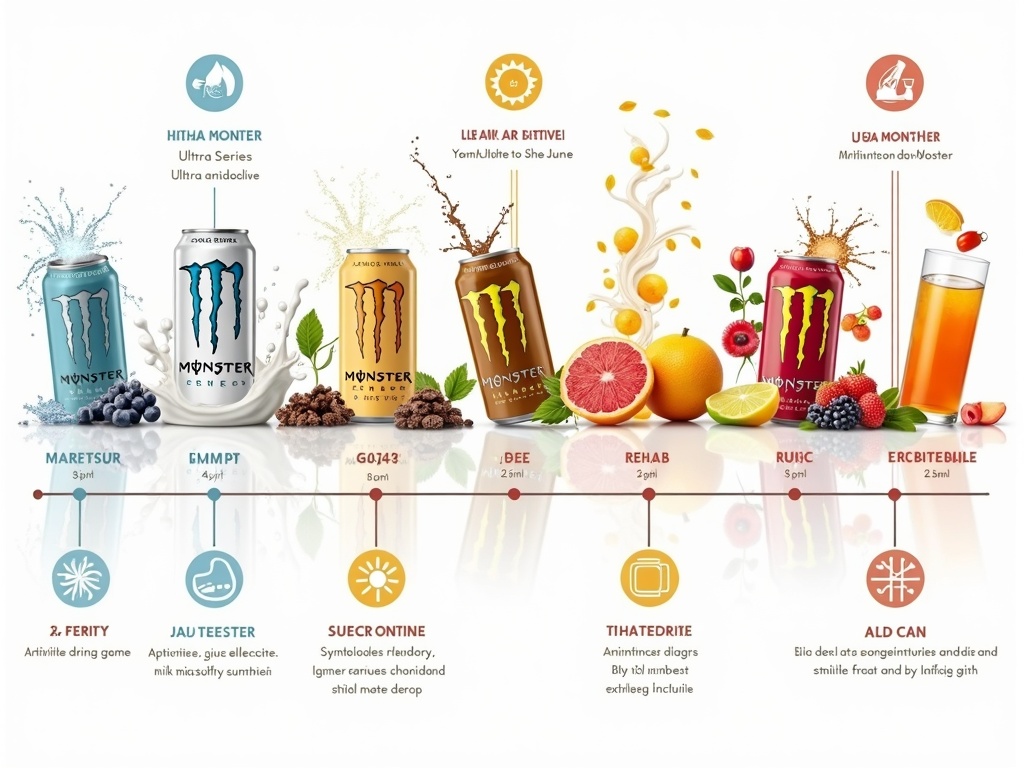
How to Read and Find Monster Expiration Dates
I always check the bottom rim of every Monster can before purchasing or consuming one. The date code appears stamped directly onto this area, making it easy to locate once you know where to look. Monster Energy uses different formatting depending on which production facility manufactured your specific can, but most follow a straightforward month-day-year pattern like “MAR3025” for March 30, 2025.
Some production sites employ internal lot codes alongside the standard dating system. These additional codes help manufacturers track specific batches for quality control purposes. However, every Monster can displays a clearly visible “Best By” date that consumers can easily interpret. I look for abbreviations like “BB,” “Best Before,” or “Best By” followed by the actual expiration information.
Smart Shopping Strategies for Fresh Stock
When buying Monster drinks in bulk or shopping at discount retailers, I make date verification a priority. These purchasing scenarios often present higher risks of receiving cans approaching their expiration dates. Discount stores sometimes acquire overstock or products nearing expiration at reduced wholesale prices, passing along savings but potentially compromising freshness.
Consider these key factors when selecting Monster drinks:
- Check multiple cans in a case pack, as manufacturing dates can vary within the same shipment
- Compare dates across different flavors, since some varieties move faster than others
- Verify that specialty or limited-edition flavors haven’t been sitting on shelves longer than regular varieties
- Examine cans stored in direct sunlight or high-temperature areas more carefully
Most retailers implement FIFO (First In, First Out) rotation systems to ensure older inventory moves first. However, this system isn’t foolproof, and older cans sometimes remain hidden behind newer stock. I’ve discovered cans with dates several months apart sitting side by side on the same shelf. Taking a moment to check dates prevents disappointment and ensures you’re getting the full shelf life from your purchase.
Online shopping presents unique challenges for verifying Monster drink freshness. Many e-commerce platforms and third-party sellers don’t guarantee specific expiration dates or warehouse stock rotation. Before completing an online purchase, I contact sellers directly to confirm their current stock dates or inquire about their warehouse turnover practices. Reputable sellers usually provide this information willingly and may even guarantee minimum remaining shelf life.
Some online retailers specialize in surplus or discounted beverages, which can offer significant savings but require extra vigilance regarding effects of drinking energy drinks past their prime. I’ve learned to factor potential freshness issues into the overall value proposition when considering these deals.
Understanding how caffeine content and other ingredients degrade over time helps inform purchasing decisions. Fresh Monster drinks deliver optimal taste and energy effects, while older cans may provide diminished benefits even before reaching their official expiration dates.
The bottom rim location for date codes remains consistent across all Monster varieties, from original flavors to newer releases. I’ve never encountered a Monster can without this critical information, though wear or damage during shipping can occasionally make codes difficult to read. When in doubt, I choose a different can with clearly visible dating information.
Developing a habit of checking these dates takes only seconds but ensures you’re always consuming Monster drinks at their peak quality. Whether you’re stocking up for long-term storage or planning immediate consumption, knowing exactly what happens after drinking energy drinks that are fresh versus aged helps you make informed decisions about your energy drink purchases and consumption timing.
What Happens If You Drink a Very Old Monster
I’ll tell you straight up – drinking an old Monster Energy drink isn’t going to kill you if the can remains intact, but you’re not getting the experience you paid for. The degradation process affects every component of the drink, from its signature energy boost to its taste profile.
Effects on Energy and Nutrition
When you crack open an ancient Monster, the first thing you’ll notice is how weak it tastes compared to a fresh one. Caffeine content remains relatively stable over time, but its potency diminishes gradually. You might feel a slight energy boost, but it won’t match the powerful kick you expect from a fresh can.
Vitamins take the biggest hit during extended storage. B6, B12, and B3 break down much faster than other ingredients, which means you’re losing most of the nutritional benefits Monster advertises. These water-soluble vitamins are particularly sensitive to time and temperature fluctuations.
Artificial sweeteners like sucralose start decomposing after their prime, creating an unpleasant bitter aftertaste or what I call “flat sweetness.” The carefully balanced flavor profile that makes Monster appealing transforms into something that tastes more like medicine than an energy drink.
Carbonation loss creates another major problem. Without those CO2 bubbles, your Monster becomes syrupy and overly sweet. The texture changes dramatically, making each sip feel thick and cloying rather than crisp and refreshing.
Extended contact between the liquid and aluminum can introduces metallic notes that weren’t there originally. This happens because the protective coating inside the can slowly breaks down, allowing trace amounts of aluminum to leach into the drink. While not dangerous in small amounts, it definitely affects taste quality.
I always check for warning signs before drinking any old energy drink:
- Bulging cans indicate bacterial growth or gas production from fermentation.
- Leaking containers compromise the sterile environment inside, potentially introducing harmful microorganisms.
- Strange smells when you open the can signal decomposition or contamination.
What happens after drinking an old Monster varies depending on how degraded it’s become. You might experience stomach discomfort from consuming breakdown products, or simply feel disappointed by the weak energy boost. Some people report headaches from the altered chemical composition.
Temperature abuse during storage accelerates all these degradation processes. Cans left in hot cars or stored in warm environments deteriorate much faster than those kept at consistent cool temperatures. Freezing and thawing cycles also damage the drink’s structure.
The aluminum can itself provides excellent protection against light and oxygen, two major factors in beverage deterioration. However, this protection isn’t infinite. Your body processes the degraded compounds differently than fresh ingredients, which can lead to unexpected reactions.
Bacterial contamination becomes a real concern once the can’s integrity is compromised. Unlike the gradual chemical changes I’ve described, bacterial growth can make you seriously ill. Trust your senses – if something seems off about the smell, appearance, or taste, don’t risk it.
The effects of drinking energy drinks change significantly when the product is past its prime. Instead of sustained energy, you might experience jitters without the accompanying alertness. The degraded vitamins won’t provide their intended metabolic support.
I recommend treating very old Monster cans as collectors’ items rather than consumables. The risk-to-benefit ratio simply doesn’t make sense when fresh alternatives are readily available. Your taste buds and your body deserve better than a degraded energy drink that’s lost most of what made it appealing in the first place.
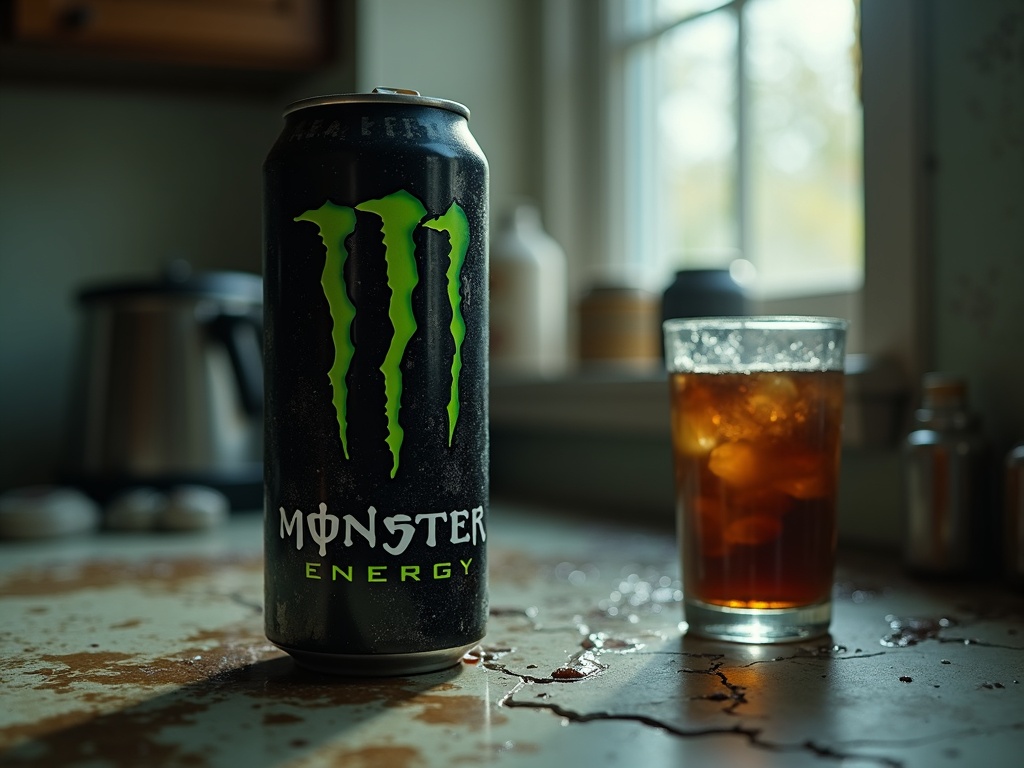
Sources:
Monster Energy Company – Product Storage and Packaging Standards
USDA Food Safety and Inspection Service – Shelf-Stable Beverages Guidance
Institute of Food Technologists (IFT) – Understanding Shelf Life and Product Stability
Journal of Food Science – Chemical Changes in Caffeinated Beverages Over Time

